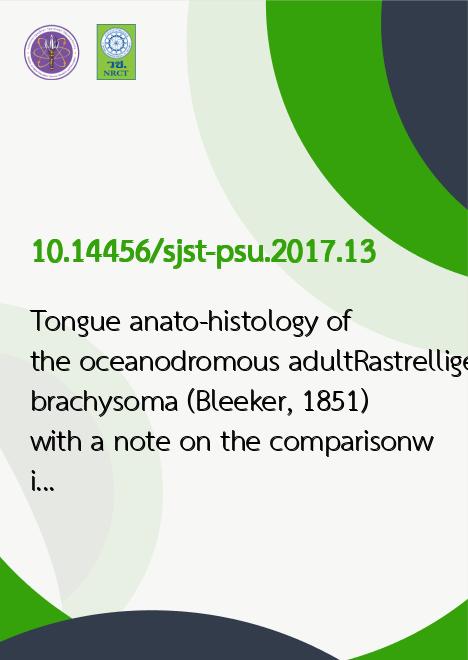
|
Tongue anato-histology of the oceanodromous adultRastrelliger brachysoma (Bleeker, 1851) with a note on the comparisonwith the tongue structure of adult R. kanagurta (Cuvier, 1816) |
|---|---|
| รหัสดีโอไอ | |
| Creator | 1. Jes Kettratad 2. Sinlapachai Senarat 3. Piyakorn Boonyoung 4. Wannee Jiraungkoorskul |
| Title | Tongue anato-histology of the oceanodromous adultRastrelliger brachysoma (Bleeker, 1851) with a note on the comparisonwith the tongue structure of adult R. kanagurta (Cuvier, 1816) |
| Publisher | Research and Development Office, Prince of Songkla University |
| Publication Year | 2560 |
| Journal Title | Songklanakarin Journal of Science and Technology (SJST) |
| Journal Vol. | 39 |
| Journal No. | 1 |
| Page no. | 117 |
| Keyword | Rastrelliger brachysoma,R. kanagurta,histology,Thailand,tongue tissue |
| ISSN | 0125-3395 |
| Abstract | Anatomical and histological structures of the tongue tissue of Rastrelliger brachysoma and R. kanagurta wereinvestigated. Anatomical structure of the tongue in R. brachysoma was poorly developed and was of triangular shape. Thehistological and histochemical technique showed the tissue to be principally composed of three layers: tunica mucosa, tunicasubmucosa and osteocartilagionous skeleton. Stratified epithelium of its mucosal surface was interrupted with several celltypes including goblet cells and taste buds. Numerous teeth with elongated shape were also found centrally on the anteriortip of the tongue. They are found among a few dermal papillae of the tongue. Tunica submucosa consisted of connectivetissue, blood vessels and pigment cells. When compared anatomically and histologically with that of R. kanagurta, theoverall morphological was quite similar. However, some histological structures including taste buds and teeth of R. kanagurtawere rarely seen. Rastrelliger kanagurta also tended to have more goblet cell than R. brachysoma. Rastrelliger kanagurtatended to possess less overall histological structures of the tongue. This difference could potentially cause by differentfeeding adaptation between the two species. Regardless of the differences found between the two species, both are stillconsidered as herbivores. |
